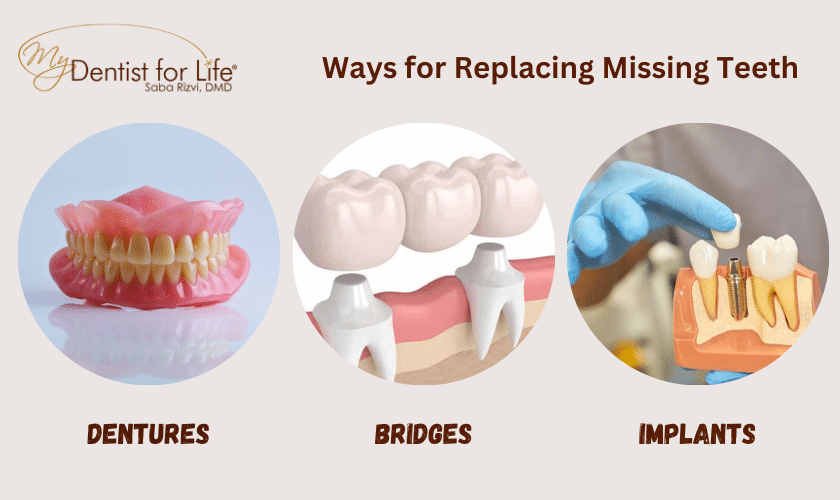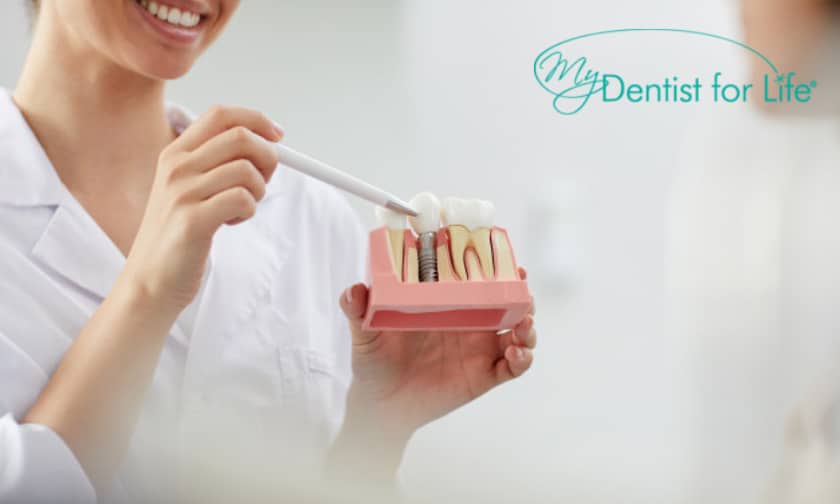ONLINE SCHEDULING AND VIRTUAL CONSULTS AVAILABLE

4 Ways for Replacing Missing Teeth: A Guide to Your Options

Missing teeth can affect your eating habits, speech, and confidence. Fortunately, there are many solutions available to replace missing teeth. Let’s look at some of the most common options for replacing missing teeth and how they work.
Best Ways to Replace Missing Teeth
Looking to replace missing teeth but not sure how to do it? Look no further than these 4 ways to replace missing teeth!
Way 1. Dentures
Dentures are one of the most traditional solutions for replacing missing teeth. They come in two forms – full dentures and partial dentures. Full dentures are used when all the natural teeth have been removed from the mouth; partial dentures fill in gaps left by a few missing teeth. Dentures are made from an acrylic resin base with prosthetic replacement teeth attached to them. They fit into the mouth just like natural teeth but sometimes require adhesive to keep them in place.
Way 2. Bridges
A bridge is a more permanent solution for replacing missing teeth than dentures. A bridge consists of two or more dental crowns fitted over existing healthy teeth on either side of the gap left by a missing tooth or multiple missing teeth. This creates an anchor point for a false tooth (or multiple false replacement teeth) which is then securely bonded between them to close the gap in your smile. Bridges can be made from gold, porcelain-fused-to-metal, all-porcelain, or all-ceramic materials, depending on your needs and budget.
Way 3. Implants
Implants may be right for you if you want something that looks and feels like natural teeth. Implants consist of small titanium posts surgically inserted into your jawbone where your natural tooth root once was located; these posts act as anchors for replacement crowns that look just like real teeth and feel almost indistinguishable from their natural counterparts! Dental implants give you the strength and stability you need to chew food again without worrying about having any setbacks caused by ill-fitting dentures or bridges slipping out of place while speaking or eating. The downside is that implants may not be covered by insurance as much as other replacement options; however, they can last up to 25 years with proper care!
Way 4. Crowns & Onlays
Crowns and onlays (also known as indirect fillings) are other options if you need to replace one or two missing teeth instead of having an entire set of false replacements put in place at once – they’re also ideal if you don’t want an implant due to cost considerations. Crowns and onlays are custom-made ceramic material to match your existing natural teeth so that it blends seamlessly with your smile! They’re also stronger than traditional fillings since they cover more surface area around each tooth than regular fillings – this makes them ideal for lasting long-term without needing frequent repairs or replacements down the line! Plus, they offer protection against further damage, such as decay caused by bacteria in hard-to-reach spots around each tooth’s root system!
Final Words
No matter what type of solution you choose for replacing missing teeth, make sure it will last long-term without needing frequent repairs or replacements down the line! You should always consult a dentist near you before deciding which option is best suited for your needs to get the maximum benefit from your choice – dental implants, bridges, crowns/onlays, or dentures! Taking proper care of whatever solution you choose will help ensure its longevity while also giving you peace of mind knowing that your smile looks great no matter what life throws at it! Thanks for reading this guide on replacing missing teeth – we hope it has helped give you insight into some options available today!
FAQs:
A: Missing teeth are often the result of poor oral care, but lifestyle habits like smoking and drinking can also cause damage to your smile. Injuries from sports or accidents could also lead to tooth loss, with certain congenital disorders resulting in fewer teeth than normal. By proactively managing diet and hygiene regimens now, you’ll be able to keep those pearly whites shining for years!
A: Replacing a missing tooth can come with significant financial considerations. Patients should be aware that the treatment cost depends on factors such as which replacement option they choose, how many teeth are being replaced, their dentist’s expertise and experience level, and the office location. Most dental offices offer payment plans to provide greater flexibility in covering upfront costs associated with this potentially expensive procedure. These options will generally be discussed during an initial consultation appointment.
A: Accidental tooth loss from contact sports can be minimized by investing in a custom-fitted mouthguard and regular dental visits. Good oral hygiene at home, like brushing twice daily and flossing once per day, plus biyearly checkups, are important for preventing gum disease or decay – the main culprits behind most people’s lost pearly whites.




